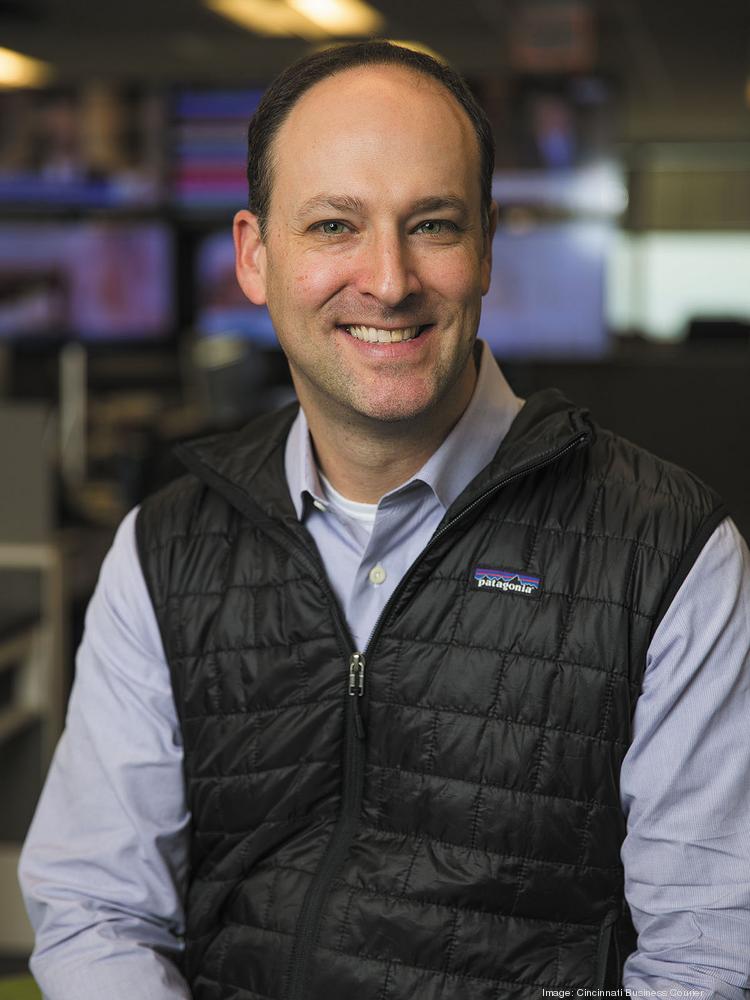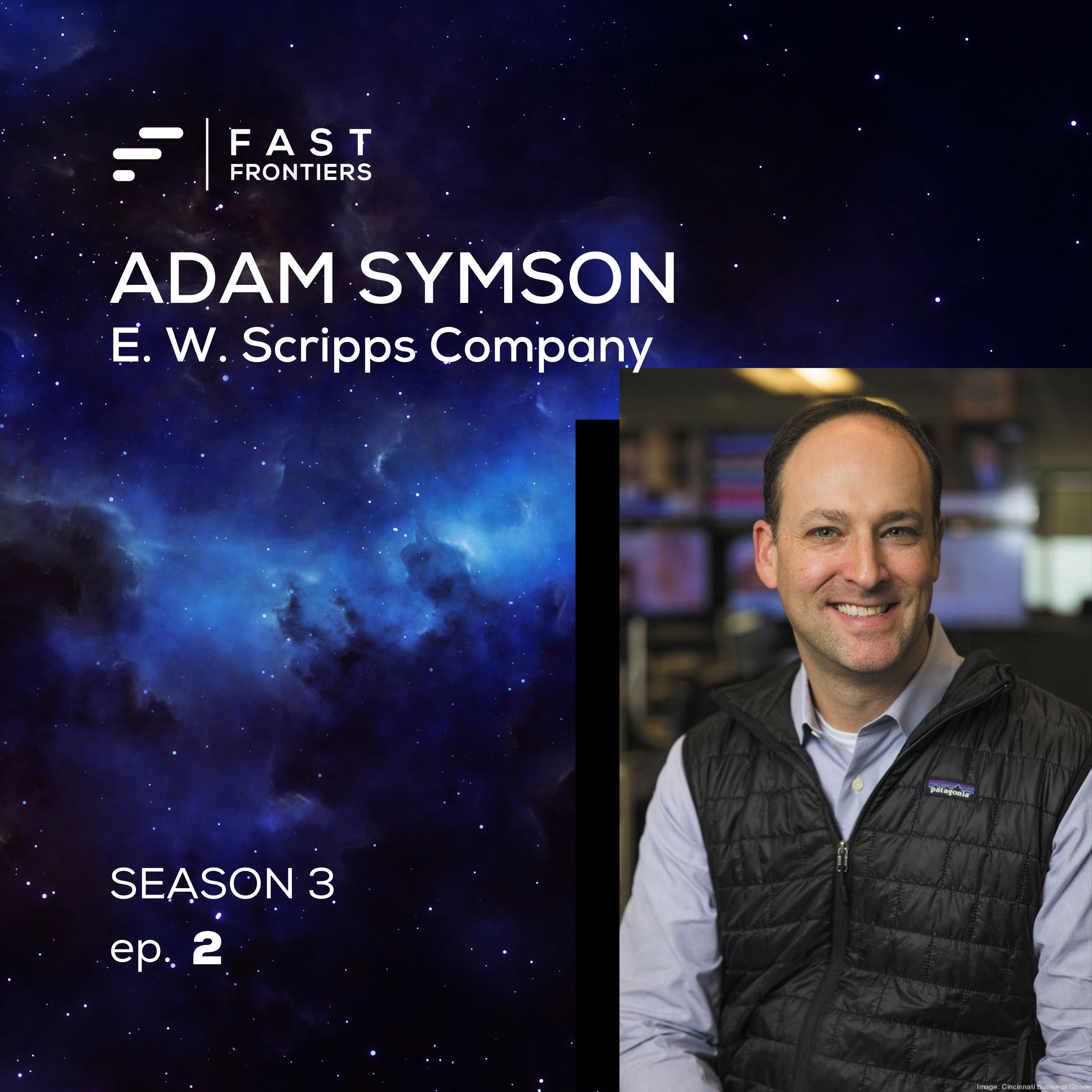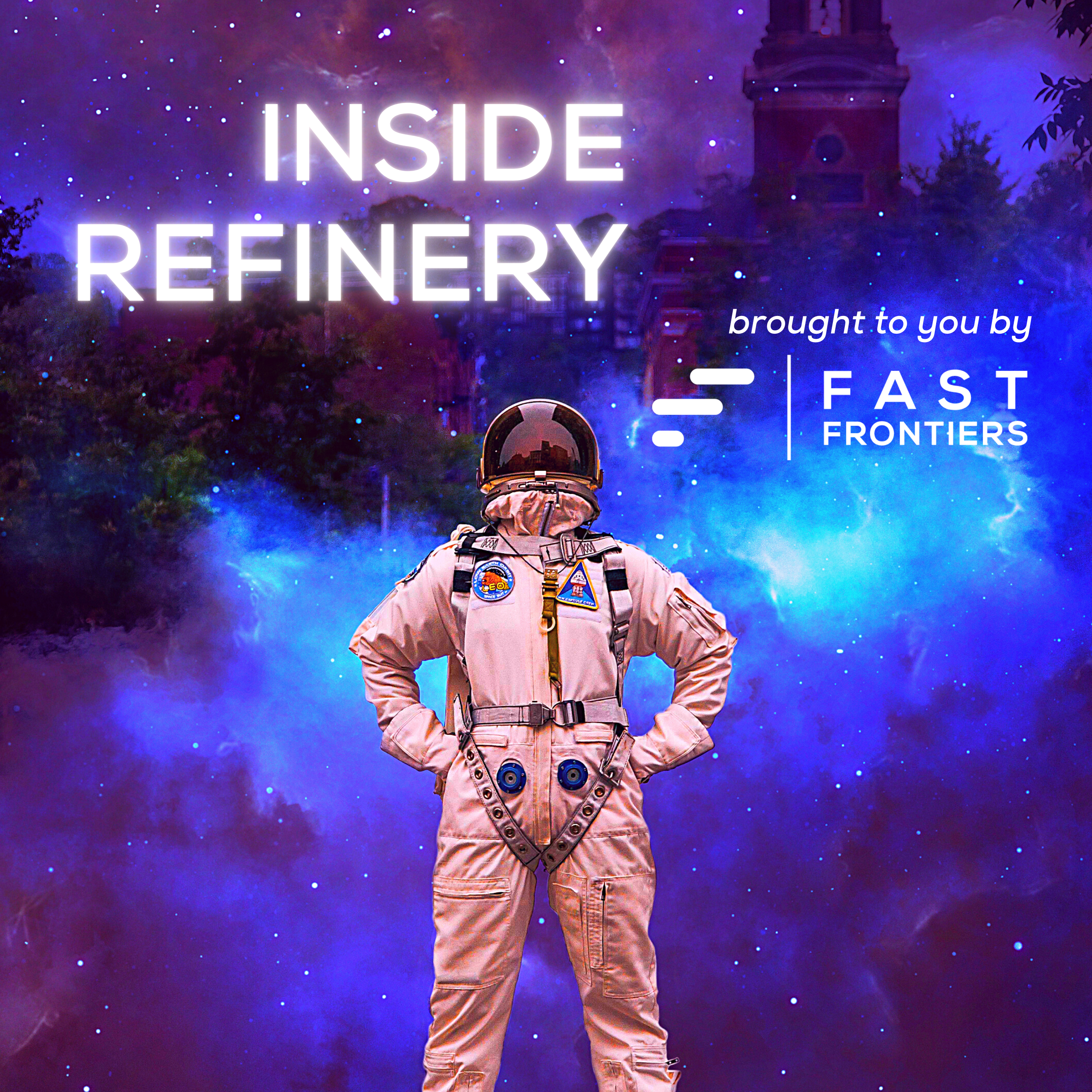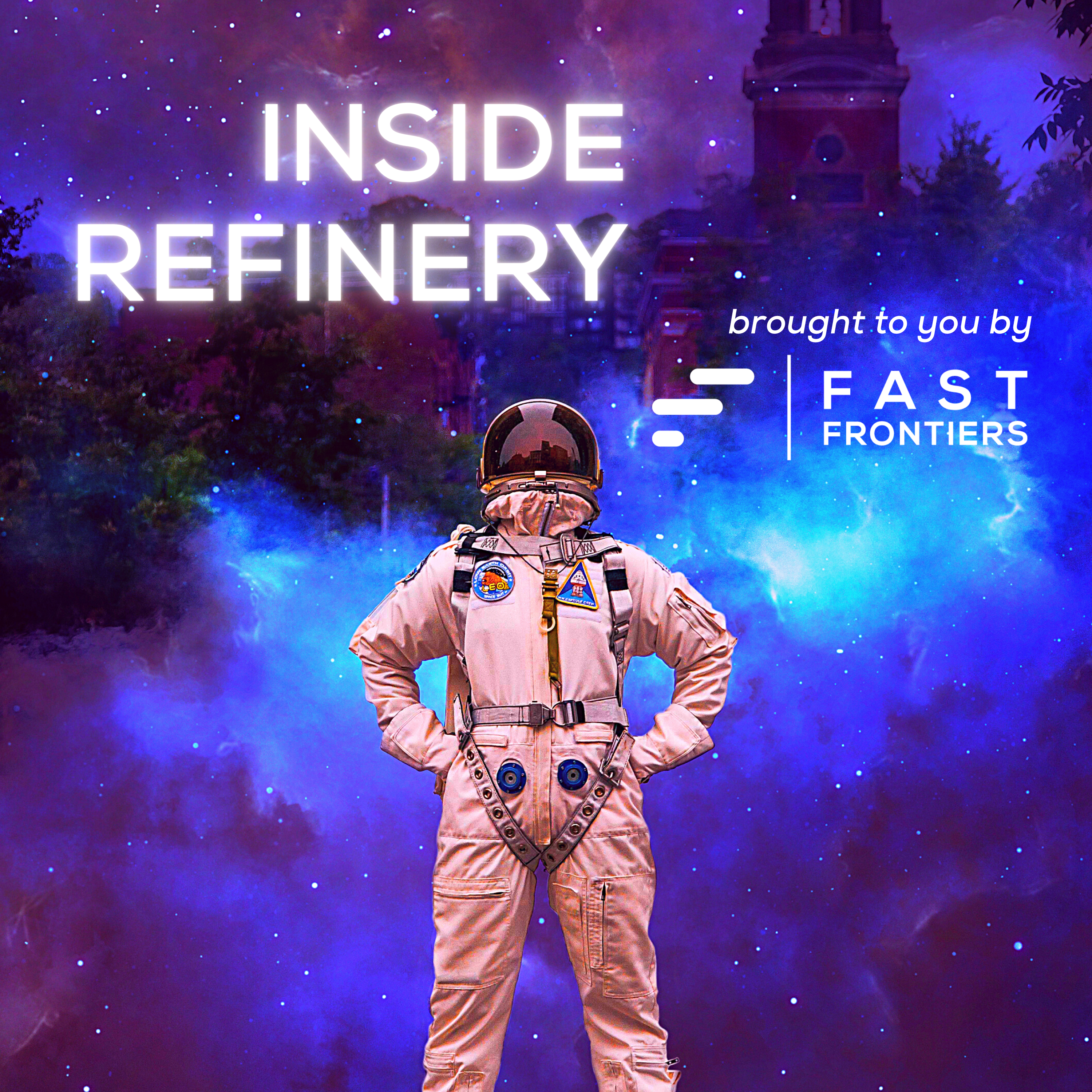S3 Ep 2. Adam Symson: E.W. Scripps
- 0.5
- 1
- 1.25
- 1.5
- 1.75
- 2
Tim Schigel : Welcome to Fast Frontiers. I am your host, Tim Schigel managing partner of Refinery Ventures. In today's episode, we're talking with Adam Symson, president and CEO of the E.W. Scripps Company in Cincinnati, Ohio. Prior to becoming CEO in August 2017. Adam was Scripps Chief Operating Officer overseeing the company's broadcast TV, radio, and digital media divisions. As Chief Digital Officer from 2011 to 2016, Adam was responsible for Scripps digital businesses and for leading the company's efforts to develop new lines of business in emerging media, through investment and acquisition. In this episode, we'll dive into the disruption of television where I learn new terms like 'time poverty'. We're also going to talk about consumer choice and how Scripps is evolving with over-the-air broadcasting and been the country's largest holder of broadcast spectrum. The biggest theme, or so what I hope we can take away from this conversation is the role that mergers and acquisitions plays in innovation for large companies. It's difficult for a big company like Scripps to think that it's going to be able to innovate organically from within. They spend a lot of time looking externally at opportunities to integrate new technologies, new businesses, and new media platforms. Scripps has been comfortable acquiring products and services and developing and growing them, and sometimes spinning them off. Either way, it's created tremendous shareholder value in terms of the learning, as well as the value that they built in those businesses. Please enjoy my conversation with Adam Symson. Adam Symson, welcome to Fast Frontiers, glad to have you.
Adam Symson: Tim, it's great to be here with you.
Tim Schigel: I've been looking forward to this conversation for quite a while. We got to know each other before you became CEO of Scripps. First of all, I'd just love to hear how that transition has gone going from head of digital, to being CEO of such a prestigious company, a company that's been around for such a long time. And it's one that I'm sure the process and the vetting and everything was pretty extreme to make sure that they kept the business in good hands. Just take us through a little bit of that evolution of yours?
Adam Symson: Oh sure. We had a lengthy succession process. I think it's well, sort of thought that succession is one of the most important roles of both a sitting CEO and the board of directors. And so our company had been focused on succession for some time. To be perfectly frank, I thought of myself as very much a dark horse. I was the company's Chief Digital Officer. We were losing quite a bit of money in our digital endeavors as we work to transition the company. And I think I sort of gave myself very little chance of becoming the CEO. So when the board of directors approached me about becoming Rich Boehne's successor, I was frankly pretty surprised. It's been a great couple of years. It's been, I would say more than I bargained for, to be perfectly frank. We pretty immediately after I took over, went through a proxy fight, which we won. We've transformed the company through both restructuring and cost cuts, but then through adding a lot of scale with M&A, and then most recently last year, really transforming the business through a very large, the largest acquisition that the company's ever done. And we've endured a pandemic. Which I don't think there was a roadmap to for anybody to follow. It's been a really a terrific adventure.
Tim Schigel: Well, there's a saying that I learned a number of years ago that, it applies and you remind me of which is companies aren't growing unless the CEO is growing. You've clearly been stretching. And I think that also benefits the company and everybody else who works with you.
Adam Symson: Yeah. And look, we have a fantastic team of leaders at the company, and I'm lucky to be surrounded by people who are way better than I am and their disciplines. And I rely very, very heavily on their guidance and their expertise. And I think we've done a great job as a team moving this company forward.
Tim Schigel: The theme of this podcast, what we want to talk about is innovation and how entrepreneurs innovate and also how large companies innovate, and that interface between the two. But to do that, it helps to set the scene I think a little bit. Being a business that's been around for 142 years, is that right?
Adam Symson: Yeah. It's a long time.
Tim Schigel: And every company today needs to think of themselves as a tech company. So managing that evolution and transition is, I'm sure, a challenge. And some of your strategy given the industry you operate in with media and content and just how things are changing so rapidly, it's kind of dizzying, and I've heard you explain it before, but if you could walk us through how you think about the strategy of Scripps in this environment?
Adam Symson: Well, the company has for every one of those 142 years been totally focused on evolving to meet the media consumer where they are. This company was certainly one of the first and the largest at a period of time, newspaper chains. And yet I don't think the company ever felt itself to be a newspaper business. I think it considered itself to be a journalism business, a media business. That allowed it to always be willing to invest through the P&L and through M&A to continue and expand. It was one of the first companies that was in Washington DC in line to get radio licenses when radio was just being commercialized, and likewise, one of the first companies to get television licenses. For a period of time, we were an MSL and an actual cable company, and we sold that business to Comcast. And then we became a cable programmer, launched HGTV, acquired the controlling interest in the food network. We spun those businesses out in 2008 and more recently in 2014, they were acquired by Discovery for $14 billion. We were a company that transitioned out of the newspaper business and doubled the size of our broadcast portfolio when we in 2014 exited newspapers to journal media group. The company has never really been satisfied to stand still. And I think I fit really nicely in a way, because I feel very similarly. I think if you're standing still, you're falling behind and that's especially true in the media space. Innovation, I think, has long been a part of the culture of this company, it's in our DNA. And I think it will continue to be in the way we run the business.
Tim Schigel: Okay, talk a little bit about how you navigate the world of streaming and over-the-air broadcast, et cetera? I think it's fascinating. And I want to dive into that a little bit more.
Adam Symson: Yeah. The television business itself is being significantly disrupted, it's already been disrupted when consumers woke up one day and realized they had choice, they took it. And I think that's the natural course of things. It used to be that our TV businesses operated it as almost oligopolies. There were a couple of television stations in a market then came cable and cable created more competition and more fragmentation. Then the internet came along and broke down geographic boundaries, and now you can get your news and your information pretty much in any way you wanted. And so we've had to really step back and assess for ourselves whether or not our product was both lovable and necessary to compete on an even playing field. I talk all the time with our executives about the need for us to be able to compete, not only against competitors, but against time poverty. I mean, people have more options than ever. And so when we think about what's going on in the television business, I feel like my charge is really to make sure this company is positioned to participate in the future of media and the future of television, no matter how consumers choose to get it. Whether its through pay television like cable and satellite, whether it's through OTT, over-the-top digital technology, whether it's subscription video on demand or whether it's over the air.
Tim Schigel: I love that word time poverty. I always talk about the attention economy and everybody's competing for our attention, but not the flip side, time poverty, which is a good one. I also wonder if there's subscription fatigue as well. I've noticed, oh, I subscribed to this now I've got to subscribe to that. And, oh, did you hear about that new show it's on Discovery plus. Oh shoot. Now I got to subscribe to that. At what point do we get saturated?
Adam Symson: I think we're actually there Tim. The average consumer has 12 subscription services. Millennials have 17 subscription services that includes video and audio, other pay services. Oftentimes we're signing up for these things, we're putting them on our credit cards and they just continue. What started out as a move towards economic efficiency, the idea that you would cut pay TV and cobbled together your own skinny bundles has become in some ways more, I think expensive for the American consumer than when we started this process back, prior to, let's say 2009, 2010. That's actually where we see the biggest opportunity for Scripps. We have found that alongside the growth of over-the-top television and subscription video on demand services over the year has been growing, over-the-air is the most ubiquitous streaming platform, broadcast television. We are the country's largest holder of broadcast spectrum. And what we have seen is that younger people especially are plugging in digital antennas and they're discovering an entire ecosystem of free television. Some of them never realized television was free in the first place because they were born into the idea that you have to pay for cable. And when they realize that they can plug in television and get a whole host of premium quality entertainment options that they can watch in a lean back experience, right alongside their SVOD platforms, and it's free. That's really what we see powering the growth of over-the-air. The other factor I think, and I don't know, maybe you have the same experience I do. There's a content glut. I am subscribed to a lot of the SVOD services. And yet I still find myself at some point sitting on the couch in the evening, watching television and realizing that I don't know what to start next. I've just finished binge-watching one show. And yet I'm not sure what to start next. And certainly Netflix and Prime and Hulu, they do their best with data to try and curate a response for me. But sometimes I just want to put the television on and have a lean back experience and just watch. And it's in that consumer proposition that we see the growth of free over the air television and the real opportunity for Scripps as the largest free over the air television company in the country.
Tim Schigel: No, the over-the-air is surprising, in the numbers. And I'm-
Adam Symson: I'll give you an example. When we think about how popular Friends or The Office, for example has been, I mean, The Office has been off the air for a long time as a new show, and yet it's remained incredibly relevant and it's remained incredibly popular. And it's done that because it's remained in the linear space. People have continued to experience The Office through what we call collision viewing. You're flipping around and you find it. And that's, what's really allowed some of the on demand players to use it as a vehicle to convert people into subscribers. When I'm talking to content owners, they fully recognize that linear television and free television is a really important way for them to keep their franchises fresh, for them to keep their titles out there, because if something goes away and then just ends up in the big pile, that is the SVOD services. There's very little chance that it's going to be rediscovered, especially for a new generation. I was in New York before the pandemic started. And some friends of ours asked us to stop by the NBC store to pick up a Friends hat for their kids, which I thought was so funny because Friends is something that we watched when we were out of college. Now it's popular again because it's being rediscovered. My daughter's just gone through all of the episodes of Friends. I think it's important for content owners to recognize that in order to battle that content glut, data has one role in aiding and discovery, but the other role is still going to be the discovery that people have through collision viewing through linear television, through flipping around and leaning back and enjoying something and then saying, hey, how do I get more of this? And on my terms. And we're very comfortable with the interplay between linear television and on demand.
Tim Schigel : Well, I'm learning a lot of new phrases collision viewing, time poverty. I love it. This is great. Yeah, the happy accidents. Well, and what's interesting about your strategy is, so your omnichannel, Omnimedia, which is smart, at scale, which is the important part. And so who else is out there that's like that, that has that profile?
Adam Symson: There really is not another company focused in the free broadcast television space like we are. And a lot of that has to do with the moves we made over the course of the last year. We were already the largest, what we would call multi-cast broadcaster, using excess spectrum from broadcasters to deliver niche programming through our channels, Court TV, and Laugh, Grit and Court TV Mystery, and Balance the nation's first broadcast African-American focus network. When we acquired ION last year for $2.65 billion. What we did is we took the next natural step to acquire the distribution. And so today we own all of that broadcast spectrum, we reach through our own spectrum and through affiliation agreements, almost a 100% of US households. And if you think about it, broadcasting is really ubiquitous. Everybody can get broadcast television. All you need to do is plug in a digital antenna, many devices already come with those antennas integrated. While there's incredible fragmentation in the OTT or the digital delivery space, the truth is that there's very little fragmentation in the over-the-air space. I mean, if you plug in a digital antenna, you're going to see your big four networks. You're going to see our networks. You're probably going to see 25 or 30 quality products, including some of the public broadcasters. At Scripps we own an enormous share of that electronic program guide, which is I think, where now advertisers recognize the opportunity to do business with us, because we're the only place that they can reach cord cutters. They're not on cable. If you're a subscription video on demand fan, marketers tell us all the time, they're finding it difficult to reach SVOD users, because SVOD platforms don't have advertising. And so the place to reach SVOD consumers is in free over-the-air television. And we are seeing a significant growth and that's obviously what's powering our growth at the company. And that's what was behind the economic thesis behind that acquisition and bringing all of our networks together in one platform with the new Scripps networks.
Tim Schigel: So shifting gears a little bit from technology, but not really, still interested in the technology angle on your view of an E.W. Scripps long history in journalism itself, not just the distribution of journalism, but journalism itself and how technology might be able to solve some of the problems that we're seeing, that we have been introduced via social media.
Adam Symson: Yeah. I mean, it's a dilemma. On the one hand, we are absolutely in the midst of the golden age of media from the consumer's perspective. I mean, if you want to read about or watch about anything, it's all available on the internet. On the other hand, social media and the democratization of the creation of this content has introduced problems. And we have a real, I would consider it a second pandemic in this country with respect to news literacy and navigating misinformation. When I think about my kids, for example, my kids will graduate high school without some of the same civics oriented education that we all had growing up, because we've tuned our schools towards more of a common core orientation, teaching to tests. And of course, when you teach the tests, that which is not on the test, sort of ends up a little bit by the wayside. And so kids are not necessarily being taught how to navigate this complex content ecosystem. And at the same time they are graduating high school, they are moving into college and into their lives with a much more complicated ecosystem than we ever had to contend with. You think about for us, the sources of information you had were professionalized, they were at least considered to be a legitimate to start. And so while we had to navigate differences between advertising and journalism, for example. Today, many of our young people don't have the skills to differentiate between advertising, native advertising, propaganda, journalism, flat out misinformation and we've seen in this country what can happen when you know that educational link is missing. We do a lot of work with the news literacy project in Washington, DC based nonprofit to bring news literacy curriculum to schools. We're behind with the NLP, the nation's first news literacy week. We're really focused on this, not only because of course it's important for our business, because we need news consumers in order for us to have viable news products. But because this country has been around for 142 years as a steward of democracy, and it might sound hyperbolic, but the truth is we need for us to have a healthy democracy, we need citizens to be able to navigate this content ecosystem well. And what we've seen in this country over the last several years, I think is a really good example of how misinformation and intentional disinformation can actually give rise to the issues that have real physical manifestations, as we all saw on January 6th. I do think technology has played a role in creating this problem, but I think we all have the ability to help bring about a solution.
Tim Schigel: When looking for solutions. So innovation, how you think about that innovation staying on the forefront. I mean, you have your north star, obviously, which is the consumer and you made that point at the very beginning. It seems that again, for a larger company, a company that has been around a while M&A activity plays a big role in helping you understand what's out there and you've done quite a bit of it. Can you talk about what role M&A plays in your innovation thinking?
Adam Symson: Yeah. I think it's really difficult for a big company like ours to always think that it's going to be able to innovate organically from within. We have spent a lot of time focused looking externally at opportunities for us to integrate new technologies, new businesses, new media platforms, really the transformation of this company all came about as a result of M&A, we were probably one of the first, we were one of the first companies to acquire a podcasting business. Then when we acquired Midroll Media and I used to talk to investors about podcasting, people had no idea what it was. And then we acquired Stitcher and then Triton and really grew one of the country's largest podcasting businesses. At the same time, we also recognize that we're going to be limitations to our ability to foster its growth as the industry began to really grow around us. And we recognize that those businesses would be better off in the hands of audio only focused companies that would be able to deploy tremendous capital in order to compete in a much more competitive marketplace. And so we sold our businesses, Midroll to Sirius XM, and then more recently Triton Digital to iHeart. So I think the company has long been comfortable creating value as both an operator where you grow something organically and recognize the opportunity to continue its expansion, but also has been comfortable acquiring things, developing them, growing them, and spinning them off as we did with the Scripps networks in 2008, as we did with our cable assets prior to that. It's just another way I think the company is comfortable evolving. One of the things I think we look to M&A for is, and I think it's sort of part of the culture of the company. You can never be too comfortable in your strategy. You always have to be willing to recognize that your strategy requires evolution, maybe even revolution. I loved podcasting. I love digital audio, but I also, personally... I mean, I really, really love it. And I do think it's going to be one of the most important platforms for the future of journalism. But at the same time, I had to be willing to recognize as an asset manager at this company, that those businesses would be better off in the hands of companies with significant scale in audio. And that with valuations as they were, our company had an opportunity to exit the business and create tremendous value for our shareholders. I think it's always being willing to recognize, or to listen to those around you when they tell you, hey, listen, this is the right time for us. We've done a great job, but this business should be with somebody else.
Tim Schigel: And what do you imagine you retain? What learning, institutional knowledge, did you retain as a result of having that ownership or stewardship of those assets for that period of time?
Adam Symson: Well, look, I think anytime you spend time understanding a different ecosystem, you understand that a marketplaces' consumer. I'll give you an example. When we got into digital audio and podcasting at the time, most people were still connected to their car radios or even their radios that were on their counters or their kitchen counters. And what we started to see with the advent in 2008 of true portability with the iPhone was that younger people in particular were never without headphones on. Whether it's at the office or walking on the street, if you're in New York and you're on the subway, people are always wearing earbuds and that was relatively new. What we've witnessed is sort of the end of the quiet walk in the neighborhood because people are always listening to something. And so that created a lot of opportunity for us in the podcasting business. The podcasting was built on the back of an entirely new generation of direct response advertisers, efficient advertisers like Squarespace and Wix and Casper mattress that were trying to reach younger audiences through podcasting's efficient buying mechanisms. And now that we are in the free over-the-air television space, we are seeing some of the same advertisers moving into television because their businesses have grown significantly. They're looking to reach larger audiences. And so I think you have the opportunity to take some of what we've learned from podcasts and with respect to that audience, and now bring it to free over-the-air television. Because there's a lot of combination, a lot of age resection between the younger podcast audience, which is by the way, continuing to age as those same people are also listening and watching free over-the-air television because of the way they've taken control of their own bundles. And so I think, whether it's on the consumer advertiser side or the consumer audience side, we take a lot of what we learned from spending time in emerging media and bring it even to the businesses that we operate and that we've been operating for 70 years.
Tim Schigel: For corporate innovation leaders, if they're not very active on the M&A side, this seems to me to be a very big benefit. You can acquire these assets, you can improve them, you can build value. And most importantly, you're getting this institutional knowledge and then you may be lucky enough to sell it. You have a transaction where you've basically had your education paid for, which is terrific.
Adam Symson: Well, that's the key. I think we're always trying to focus on creating value.
Tim Schigel: Are there other ways outside of the M&A activity, other ways you think about innovation within E.W. Scripps?
Adam Symson: Look, when you're 142 years old, you don't continue to operate unless you're willing to cast a wide net and understand ways to continuously and improve your business. Sometimes I think we think about big I innovation, the development of HGTV, the work we did in podcasting, but I also think there's little I innovation that's just as important. We navigated this pandemic as a result of tremendous creativity, entrepreneurship and innovation on the parts of our employees. Television stations have traditionally run with lots of people inside buildings. You have a master control, for example, that allows you to bring in programming and punch commercials. And when we were in the midst of the pandemic, our engineering teams and our IT teams determined that they were going to be able to allow our master control operators, for example, in our master control hubs, to be able to remain socially distanced and safe, just like all of our other employees. So we have been operating in many cases with our employees in master control, operating our TV stations in some cases from the tables in their kitchens, as a result of leveraging digital technology, high speed internet and a lot of creativity in order to make that innovation keep our company moving forward. So look, I don't think innovation is constrained to just business creation. I think innovation is always about process improvement and about figuring out ways to bring new products, new opportunities to any of your consumers, the audiences and the advertisers. And I think we've been proven over and over a company, very, very comfortable with disrupting ourselves in order to improve the business and move ourselves forward.
Tim Schigel: What does the future look like if you could cast out your vision for the next 10 to 20 years?
Adam Symson: Oh my gosh. The media space is moving so quickly Tim, 10 to 20 years feels like an eternity. Look, I think first of all, television will continue to evolve and I suspect 10, 15 years from now, it's going to look very different than it does today. Those of us in markets are going to continue to evolve our business in a way that will ensure that television is both an important platform for consumers and obviously an important platform for advertisers. A lot has been made of the transition to digital advertising, but I think we've come to see that display advertising certainly has its limits as efficient as searches and as Facebook advertising is it's got its limits. I mean, I can't think of a single search phrase or Facebook ad that really draws the emotion or brings me to think about a brand the way television advertising, television storytelling does. I think we'll continue to see that happen, but I think where people consume it and how they consume it is going to continue to change. I just know that our company, the expectation I have for myself and our company is that we will continue to lead that process. And we will leverage all of our resources as one of the oldest journalism companies, media companies, as the largest holder of broadcast spectrum, to ensure that we continue to create value for all of our stakeholders. And I count among our stakeholders, our employees, but I also count, obviously our shareholders, the Scripps family, our controlling shareholders and the American people. We have this responsibility both as a journalism organization, as well as a user American broadcast spectrum to ensure that we are always stewards of this business for the benefit of the American people. And we need that more than ever.
Tim Schigel: Yeah, very well put. And speaking of stewardship, you also play a leadership role in our Cincinnati Ecosystem with Cintrifuse and various startups here. Any observations you share in terms of how Cincinnati is doing on that front?
Adam Symson: Well, I mean, look very much thanks to you and the focus you've brought both to Cincinnati, as well as to Midwest Venture. I think in general, we're making tremendous strides, probably still further to go for us to really be able to open the eyes of big CO's, Venture Capitalists, that there's tremendous entrepreneurship and creativity here, but I think we're making progress. Cincinnati itself has a lot of opportunity. I mean, I've been here for 17, 18 years. And when I first moved here people used to ask me from back home in Los Angeles, hey, Cincinnati, how's that? And I would say, "It's not that bad." And today it's a totally different story. Today I can go through a million reasons why I wouldn't move back to Los Angeles and why I think Cincinnati is the best place for us to be raising our family. And the Midwest is a terrific place to live. And I think you're going to continue to see that. I think the pandemic is going to have accelerated that as people have recognized that it's not all that to be a New York and Los Angeles and San Francisco. I think we in Cincinnati are doing our part to continue and develop a vibrant local economy. And with new job creation, lots of innovation here. And I think lifestyle wise, this community has really developed beautifully. It's a totally different kind of a community than when I first moved here and I'm proud to call Cincinnati home. And I think Scripps is proud to make Cincinnati our corporate headquarters.
Tim Schigel: Well, Adam Symson, we're proud of you and the work you're doing at Scripps and glad to have you part of the leadership of this ecosystem. Thank you very much for being on Fast Frontiers.
Adam Symson: Tim, it's been a pleasure. It's been a lot of fun.
Tim Schigel: Thanks for listening to Fast Frontiers. If you like our show and want to know more, check out our website, fastfrontiers.com. If you enjoyed this episode, please share it with others and leave us a review on your favorite podcast platform. Again, in this first week of Fast Frontier, season three, we have three great conversations to share. You can listen to them all right now. Join us next week when we bring you our first duo episode, the conversation with Nick Cromydas at Hunt Club and Kaleb Dumot of Integrity Power Search. The Fast Frontiers podcast is brought to you by Refinery Ventures. Our producer is Abby Fittes. Audio engineering by Astronomic Audio, marketing content and social media support from Content Callout and our podcast platform is Casted.
DESCRIPTION
In today's episode, we're talking with Adam Symson, president and CEO of the E.W. Scripps Company in Cincinnati, Ohio. We're going to dive into the disruption of television where we learn new terms like 'time poverty'. We're also going to talk about consumer choice and how Scripps is evolving with over-the-air broadcasting and been the country's largest holder of broadcast spectrum.
Please click on any related resources below for more information about what we discuss in this episode.
Today's Host
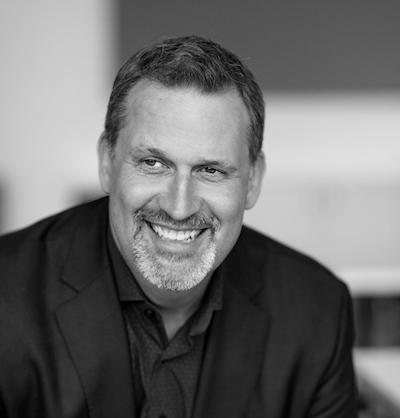
Tim Schigel
Today's Guests
